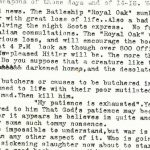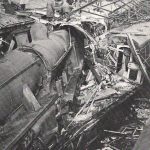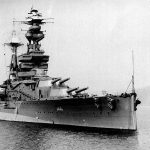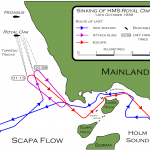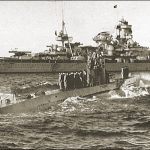Since his last diary entry only a few days before, two upsetting events had taken place which Thomas discusses immediately, one war related, and one outwith these events. Firstly, the sinking of the British battleship “The Royal Oak” in Scapa Flow, Orkney; and secondly, a railway accident at Bletchley on the London Midland and Scottish railway line.
The rail accident at Bletchley had occurred on the evening of Friday 13th October, leading to a loss of four lives and causing injury to 40 others. The Stranraer to London express train had failed to observe signals prior to arriving in Bletchley, and had crashed into the train ahead of it; the Inverness to London train which was still at the station platform having further carriages attached to it. Although a variety of factors were considered to result in the disaster, including the observed war time blackout conditions, the main cause was determined to be driver error. The report produced from the subsequent investigation can be seen in full here.
The sinking of HMS Royal Oak has become one of the most infamous and tragic losses of life for the British fleet during the Second World War campaign. Built as part of five Revenge-class battleships for the Royal Navy during World War One, she was part of the Grand Fleet which saw combat in the Battle of Jutland in 1916. The ship hit the headlines again in 1928 when two senior officers were court-martialled for what had begun as a disagreement between them and their superior regarding a wardroom dance, and had escalated into a bitter personal feud among the three.
On October 14 1939, the ship was anchored in Scapa Flow in Orkney, when the German submarine U-47 managed to navigate the seemingly impenetrable naval base and torpedoed the vessel. There was confusion aboard the ship as to what had happened, and before the crew knew they were being attacked, had been hit by more torpedoes which caused the ship to roll on her side and sink a few minutes later. With the attack being in the early hours, most of the men were still asleep in their beds, and would remain trapped there. Of 1234 individuals aboard, only 400 survived, with many of the victims being boys aged only 15-17. Although the Royal Oak was sunk in relatively low waters, the nature and speed of the sinking made it extremely difficult for those on board to escape, and has been designated as a war grave ever since. The shock of the attack lead to rapid changes at the base, and the installation of the Churchill Barriers to avoid opportunity for a repeat of the tragedy.
As Thomas stated “The Royal Oak was an old ship, but it is a serious loss, and will encourage the boche very much. How pleased Hitler will be”. The crew of the German submarine did indeed become heroes at home, and commander Gunther Prien was awarded the Knight’s Cross of the Iron Cross by Adolf Hitler himself. Scapa Flow was synonymous with bad memories previously for the Germans, having scuttled their fleet there at the conclusion of World War One, so this attack was, amongst many tactical objectives, considered revenge for the events of the preceding decades.
U-47 itself would suffer a similar fate to that it had inflicted on the Royal Oak only eighteen months later. Having last reported to their headquarters on 7 March 1941, whilst it was never officially confirmed, the submarine was believed to have been destroyed in the North Atlantic by the British destroyer HMS Wolverine, as the vessel and crew were never heard from again.
As Thomas concludes, “life is quite impossible to understand, but war is even less eassy(sic) to understand than any other aspect of it”.
Sources used:
www.wikipedia.org
www.scapaflowwrecks.com
www.royalnavy.mod.uk
www.u47.org
www.railwaysarchive.co.uk
www.orkney.com
